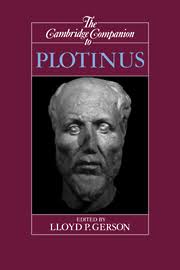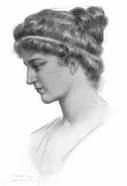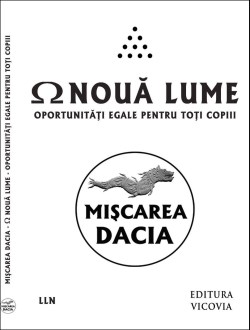 Vă invit să vă alăturaţi grupului Facebook Mişcarea DACIA, ce-şi propune un alt fel de a face politică!
Vă invit să vă alăturaţi grupului Facebook Mişcarea DACIA, ce-şi propune un alt fel de a face politică!Citiţi partea introductivă şi proiectul de Program, iar dacă vă place, veniţi cu noi !
O puteţi face clicând alături imaginea, sau acest link
Posts Tagged ‘Neoplatonism’
Hyperian History Of The World (5th Century)
Hyperian History Of The World (3rd Century)
“Hyperian History Of The World (3rd Century)
In the 3rd Century, the Hellenic world, centred on Alexandria, was awash in various, conflicting sects of Christianity, ranging from those more radical and more Jewish, to those more pagan, such as the Gnostic sects, as well as many other non-christian sects of Greek/Roman paganism. In the previous century, the religious element of these sects had taken precedence over any kind of intellectual, philosophical elements. But in the 3rd century, a great genius appeared in the world who would revive Greek philosophy and combine it with the religious sensibility of the time to produce a truly intelligent and intellectual religion. The Genius was Plotinus and his philosophical religion became known as Neoplatonism.
After travelling to Alexandria seeking philosophical wisdom, Plotinus came across a man called Ammonius Saccas, whose lectures on the philosophy of Plato so affected Plotinus that he immediately began studying under this new teacher. After many years of study under Ammonius Saccas, Plotinus began travelling around gaining further wisdom from Persian, Indian and Arab philosophers before finally settling in Rome towards the end of his life, where he spread his teachings around the great city.
Plotinus’s philosophical religion is basically the philosophy of Plato turned into a religion. Plotinus himself insisted that he was not creating anything new, but was rather producing the culmination of Plato’s philosophy. In the system of Plotinus, everything has its source in what he called The One. The One is essentially the arche, the source of everything. But for Plotinus, The One, as the source of everything, is very similar to Pythagoras’s concept of the point that contains all other points, i.e. The One is purely dimensionless and immaterial, yet contains within it everything else in the universe.
Plotinus’s system consists of a series of emanations starting from The One. The first thing that emanates from The One is The Nous, basically the same Nous as that of Anaxagoras. The Nous is the mind or the intellect of the universe, the thing that guides it and controls it. For Plotinus, the Nous contains within it all of the perfect Forms that Plato had spoken of. As the mind of the universe, the Nous knows everything about the universe and thinks all possible thoughts simultaneously.
The next emanation is the Psyche or the soul, emanating from the Nous. The Psyche is equivalent to Plato’s Demiurge. Whereas the Nous thinks everything simultaneously, the Psyche thinks slowly and as a linear process. The Psyche can access the Forms present in the Nous and use them to create the next emanation which is Nature, or the physical world, which is, as Plato said, an inferior copy of the Forms in the Nous. The Psyche is also split into two parts, firstly the upper part which is the World Soul, the collective soul of the world, and secondly, the lower part which takes the form of all the individual souls in the universe.
As these individual souls are only one emanation away from the physical world, Plotinus explains that these souls take the physical world to be true reality, when, in fact, True reality is mental rather than material, the true Forms in the Nous rather than the inferior copies of them in Nature. For Plotinus, the task of our souls is to leave behind the physical world and travel back up the emanations, firstly to the upper Psyche, or World Soul, then into the Nous itself where the True Forms are, and finally back to The One, which contains everything. This idea expands on Anaximander’s original concept that the universe begins as apeiron and shall return to apeiron.
Unfortunately, Plotinus’s religion, based on reason, rationality and mathematics, as well as the ideas of the greatest of geniuses of Ancient Greece, failed to take hold of Europe which, instead, adopted the absurd, irrational, faith-based version of Christianity which took over the Roman empire.
Of course, it is not too late to abandon the absurdity that is Christianity and revive the brilliant ideas of Plotinus, a religion which would far better have served the Romans and, indeed, the rest of the world. A religion based on reason, philosophy and mathematics is precisely what the world needs right now. The central idea can be summed up by Plotinus’s supposed last words: “Try to raise the divine in yourselves to the divine in the all.” If that’s not Hyperian, I don’t know what is.”
– Azure Circe – Hyperian

TEORIA M
TEORIA M, ultima încercare a oamenilor de știință de a formula o „Mare Teorie A Tuturor Lucrurilor” (The Grand Unified Theory Of Everything), este sortită eșecului încă de la început. De ce? Deoarece ignoră domeniul neexplorat în afara Spațiului și Timpului, domeniul lui ZERO și INFINIT. TEORIA M ăncearcă în mod explicit a preveni apariția lui ZERO și INFINIT în oricare dintre ecuațiile sale. Este „ultima dorință” și „testament” al Materialismului, încheierea Marii Nebunii, înainte de a se confrunta în cele din urmă cu Adevărul unui „partener” IMATERIAL al Lumii MATERIALE.
Iată povestea acestui Cosmos extraordinar al nostru:
Te vom duce în cea mai ciudată „călătorie”, de la Kabbalism, Zoroastrianism, Manichaeism, Gnosticism, Hermeticism, Rosicrucianism, Platonism, Neoplatonism, Tableta De Smerald, Epoca de Aur, Aleister Crowley, Filosofia Perenă, Genii, Aristotel, Entelehie, Forme și Materie, Minte și Materie, Universalităţi și Particularități, până la Materialism, Darwinism și Teoria M. Judecă tu, cine are raspunsurile mai bune cu privire la Natura Adevarată a Existentei: oamenii de ştiinţă, sau Illuminati Pitagoreici.
Destinul Sufletului tău este în joc.”

N Ox Prognatus to Anunnaki, Alien Gods and Spirituality
7 hrs ·
M-theory, the latest attempt by scientists to formulate a grand theory of everything, is doomed to failure from the outset. Why? Because it ignores the unextended domain outside space and time, the domain of zero and infinity. M-theory explicitly sets out to prevent the appearance of zero and infinity in any of its equations. It is the last will and testament of materialism, its concluding grand folly before it finally confronts the truth of an immaterial partner to the material world.
Here is the tale of this extraordinary cosmos of ours. We will take you on the strangest journey, from Kabbalism, Zoroastrianism, Manichaeism, Gnosticism, Hermeticism, Rosicrucianism, Platonism, Neoplatonism, the Emerald Tablet, the Golden Dawn, Aleister Crowley, the “perennial philosophy”, genies, Aristotle, entelechy, forms and matter, mind and matter, universals and particulars, all the way to materialism, Darwinism, and M-theory.
Judge for yourself who has the better answers regarding the true nature of existence: scientists or the Pythagorean Illuminati. The destiny of your soul is at stake.
Tags: Aleister Crowley, Aristotel, Darwinism, Entelehie, Epoca de Aur, Filosofia Perenă, Forme și Materie, Genii, Gnosticism, Hermeticism, Kabbalism, Manichaeism, Minte și Materie, Neoplatonism, până la Materialism, Platonism, Rosicrucianism, Tableta De Smerald, Universalităţi și Particularități, Zoroastrianism
Illuminati (21)
HYPATIA
Din moment ce Ziua Îndrăgostiților a fost inițial o sărbătoare păgână, vreau să profit pentru a onora extraordinara filosoafă păgână, matematiciana Hypatia din Alexandria, care este o parte majoră a tradiției hiperiene.
Nu s-a căsătorit niciodată, în ciuda multor propuneri, alegând să se concentreze asupra muncii sale. Ea a devenit șeful filozofiei și astronomiei învățământului neoplatonic. Nu se mulțumea să se limiteze la zidurile școlii, ci să se plimbe prin oraș și să discute despre filosofie cu oamenii răspândind Cunoștințe și Înțelepciune.
Hypatia a atras ura creștinilor și într-o zi a fost atacată de mulțime. Creștinii au umilit-o dezbrăcând-o și au târât-o pe străzi la „Biserica numită Cezareum”. Apoi i-au rupt carnea în timp ce era încă în viață cu ţigle sau cu scoici ascuțite de stridii, și apoi au ars rămășițele.
“Reservați-vă dreptul de a gândi” – Hypatia
“Viața este o evoluție, iar cu cât călătorim mai mult, cu atât mai mult cu Adevăr putem înțelege. A înțelege lucrurile care se află la ușa noastră, este cea mai bună pregătire pentru înțelegerea celor care se află dincolo de ea. “- Hypatia
“Fabulele ar trebui să fie învățate ca niște fabule, miturile ca mituri și minunile ca fantezii poetice. A difuza Superstițiile ca Adevăruri este un lucru teribil. Mintea copilului le acceptă și le crede și numai prin durere mare și poate tragedii, poate fi eliberat de ele. “- Hypatia
Morgue – Hyperianism.com
Philosophia (7)
„Neoplatonism
Neoplatonismul se bazează pe trei ipostaze care formează împreună Realitatea: inefabilul UNUL / ONE (echivalent cu Forma lui Platon a Binelui), INTELECTUL (NOUS) și SUFLETUL (PSIHIC).
Sufletul (Psihicul) are o parte Înaltă unitară și o parte Inferioară fragmentară.
Natura poate fi considerată ca o ipostază a Psihicului. Partea inferioară fragmentară a Psihicului este aceea care animează Natura.
În termeni matematici ontologici, Unul este Singularitatea, Nous constituie Legile Matematicii, Psihiculul Superior se referă la Colectivul Monadic, în timp ce Psihicul Inferior se referă la Monadele Individuale.
Colectivul Monadic produce Natura (prin intermediul unei contribuții energetice scăzute a tuturor monadelor), iar apoi Monadele Individuale interacționează cu Natura.
În Neoplatonism, Existența cuprinde unitatea diferitelor ipostaze.
Totul a emanat de la Unul și caută să se întoarcă la Unul. Acest lucru corespunde unui univers ciclic prin care Singularitatea (Unul) creează Universul prin Big Bang la începutul unei epoci cosmice, iar apoi Universul revine la Singularitate până la sfârșitul Epocii Cosmice (Big Crunch).
Neoplatonistii erau mult mai bine informati despre adevarata natură a Realitaţii decat oamenii de știință de astăzi. Nu este remarcabil?
Neoplatonismul, ca și Iluminismul, este despre Involuție urmată de Evoluție: Minţile se înstrăinează în Natura Materială, apoi se întorc la ele însele, exact așa cum a descris Hegel în Filosofia Dialectică.
Hegelianismul este, desigur, doar o modernizare a Neoplatonismului, iar Illuminismul modern este o modernizare a Hegelianismului.
UNUL Neoplatonic este primul (și ultimul) Principiu, sursa Existenţei (Being) și a Devenirii (Becoming).
UNUL este transcendent, indivizibil, imutabil, autosuficient, etern, necesar și perfect.
UNUL creează sau emană orice altceva, dar nu este el însuși, nici creat, nici emanat.
Nous este Matematic, Noumenal și Logos;
Psihicul este Ştiințific, Religios și Mythos.
„Materia” este inferioară Minții și este reală numai prin interacțiunea sa cu Sufletul Universal.
Materia este imperfectă, mutabilă, plurală și potențială. Unul, Nous și Psihicul Superior sunt în afara spațiului și timpului, iar Psihicul Inferior și Materia sunt în spațiu și timp.
Lipsindu-i orice legătura cu „Binele” (UNUL), Materia este ipso facto „Rea”. Acest Rău infectează și corupe Sufletele care interacționează cu Natura Materială.
Doar partea Inferioară a Psihicului este în contact cu Materia. Restul este imun la Materie. Doar partea inferioară a Psihicului este supusă Suferinței – tocmai pentru că interfațează cu Materia Malefică.
Ființele vii cuprind o parte inferioară (corpul material), o parte superioară (Psihicul Inferior) şi o parte și mai înaltă (Psihicul Superior) și partea cea mai înaltă (Nous-ul Raţional). Dincolo de acestea se află UNUL („Dumnezeu”, răspunsul la toate).
Ființele umane stau între Sensibil și Inteligibil, între Sentimente și Gânduri.
Corpurile sunt instrumentele inferioare ale Sufletelor.
Sarcina Sufletelor este să se îndepărteze de Lumea Materială Rea și să urce la UNUL (Binele), prin Contemplarea Rațională și dobândirea Cunoașterii (gnoza).”














